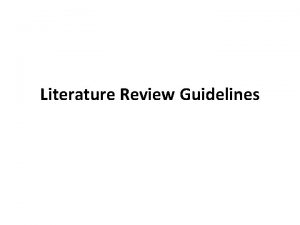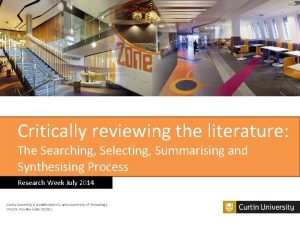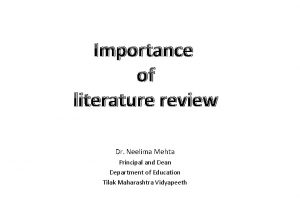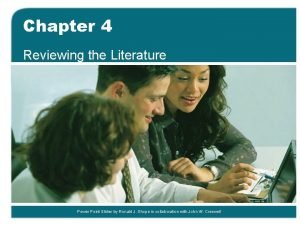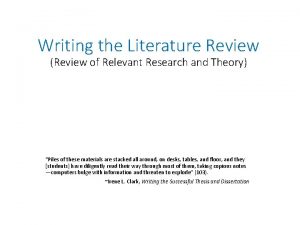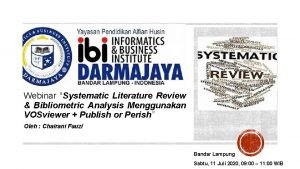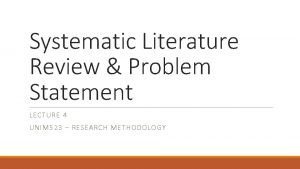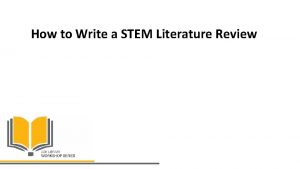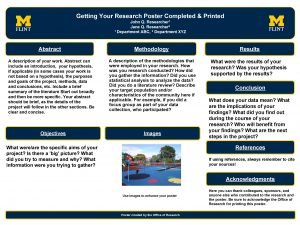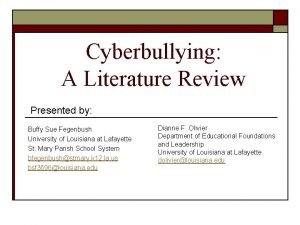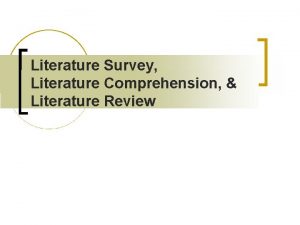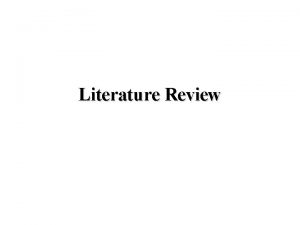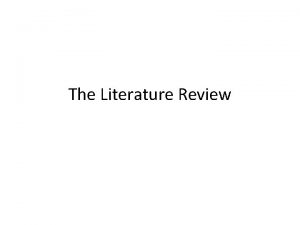Research Strategies Chapter 6 Research steps Literature Review






























- Slides: 30

Research Strategies Chapter 6

Research steps Literature Review • identify a new idea for research, • form a hypothesis and a prediction, Methodology • define and measure your variables, • sampling • how to treat them ethically, • the next step is to select a research strategy

Strategies, Designs, and Procedures

types, srategies, designs, and procedures • The process of developing a research study can be broken down into 3 -4 distinct stages: determining a research type, research strategy (method), determining a research design, and determining research procedures.

Definitions of Quantitative and Qualitative Research(Creswell) The term quantitative refers to the type of data or variables that this research examines Quantitative Research A type of research in which the researcher decides what to study; asks specific, narrow questions; collects quantifiable data from participants; analyzes these numbers using statistics; and conducts the inquiry in an unbiased, objective manner. Qualitative Research A type of research in which the researcher relies on the views of participants; asks broad, general questions; collects data consisting largely of words (or text) from participants; describes and analyzes these words for themes; and conducts the inquiry in a subjective, biased manner.

Research Strategies (methods) The 5 basic research strategies are • the experimental strategy • the quasi- experimental strategy • the non-experimental strategy • the correlational strategy • the descriptive strategy.


Experimental vs non-experimental

Random vs non-random assignment

Research Design, Research design addresses how to implement the strategy It is not enough to say the design is experimental or correlational • Group versus single individual • Same individuals (within subjects) versus different individuals (between subjects) • The number of variables to be included

Research Procedures • Exactly how the variables will be manipulated, regulated, and measured. • Exactly how many individuals will be involved. • Exactly how the individual participants or subjects will proceed through the course of the study.

Internal and external validity • Internal validity of a research study is the degree to which the study accurately answers the question it was intended to answer. • External validity refers to the extent to which we can generalize the results of a research.

Threats to external validity

Generalizations • There at least three different kinds of generalization, and each can be a concern for external validity. • Generalization from a sample to the general population. • Generalization from one research study to another one. • Generalization from a research study to a real world situation.

Threats to external validity

Category 1: Generalizing Across Participants or Subjects Selection bias 1. Local samples 2 - College students 3 - Volunteer bias 4 - Participants characteristics (gender, age)

Category 2: Generalizing Across Features of a Study • Novelty effect • Multiple treatment interference (extra treatment) • Experimenter characteristic (gender, race, personality, ability)

Category 3: Generalizing Across Features of the Measures • Sensitization ( the treatment works only if subjects are pre-tested, it is the measurement that works not the treatment) • Measurement (the results of the study may be limited to a specific measurement) • Time of measurement (how long after treatment it is measured)

Threats to internal validity

A. Extraneous Variables Any variable in a research study other than the specific variables being studied is an extraneous variable. Every research study has thousands of them. Does it make a difference if ? • tested in the morning or in the afternoon. • Study may be conducted on a dark and cloudy Monday or on a sunny Tuesday. • Room color, temperature, hungry, tired, sad, excited, …etc.

B. Confounding variables is an extraneous variable that changes systematically along with the two variables being studied. • EX Var = Wall color and problem solving performance • Con Var = One group of students were hungry.

C. Time- Related Variables 1 - History (Value Added-Rich schools) 2 - Maturation (Children, can change in a relatively short time). 3 - Instrumentation (the researcher doing the observing may become more proficient in making the observations in the posttest)

Time- Related Variables 4 - Testing effects ( practice, fatigue, and carryover effects) • Posttest was better just because they practiced many times in repeated measures • Posttest was worse because they were tired

Time- Related Variables 5 - Regression toward the mean: (extreme scores on one measurement tend to be less extreme on a second measurement) Blood pressure Costco

D. Other Threats • • Compensa tory equalization Diffusion (or imitation) of treatments Compensation rivalry Resentful demoralization

Threats Compensatory equalization; the comparison group is somehow compensated by others in order to make up for the fact that they are not receiving a treatment Goal: effectiveness of access to science lab Compensation: the other group uses a simulation

Diffusion (or imitation) of treatments • Knee pain

Threats Compensation rivalry when the comparison group knows what the program group is getting and therefore, develops a competitive attitude with them. John Henry effect--John Henry was a steel-driver who outperformed a machine (steam -hammer) under an experimental setting because he was aware that his performance was compared with that of a machine.

Threats Resentful demoralization when the comparison group knows what the program group is getting and get discouraged or angry and withdraw from the study.

Threats to Both Internal and External Validity • Experimenter bias (results obtained in a study may be specific to the experimenter who has the expectations) • Demand Characteristics and Participant Reactivity (cues given about the hypothesis & 4 types of human subjects) • Exaggerated Variables (70 degrees vs. 120 degrees classrooms)
 Literature review in research example
Literature review in research example Broad problem area in research
Broad problem area in research Role of literature review in research
Role of literature review in research Importance of good literature review
Importance of good literature review Chapter review motion part a vocabulary review answer key
Chapter review motion part a vocabulary review answer key The critical literature review chapter 4
The critical literature review chapter 4 What type of movement
What type of movement Chapter 6 career readiness chapter review answers
Chapter 6 career readiness chapter review answers Writ of certiorari ap gov example
Writ of certiorari ap gov example Nader amin-salehi
Nader amin-salehi What is inclusion and exclusion
What is inclusion and exclusion Narrative review vs systematic review
Narrative review vs systematic review Definition of review of literature
Definition of review of literature Literature review
Literature review Guidelines for writing a literature review
Guidelines for writing a literature review Literature review dalam penelitian
Literature review dalam penelitian Example of statement of the problem
Example of statement of the problem Literature review gantt chart
Literature review gantt chart Scribbr
Scribbr Theoretical framework vs literature review
Theoretical framework vs literature review Introduction of review of literature
Introduction of review of literature Literature review on enterprise risk management
Literature review on enterprise risk management Difference between literature review and introduction
Difference between literature review and introduction Synthesis of review of related literature example
Synthesis of review of related literature example Introduction to literature
Introduction to literature Stem literature review example
Stem literature review example Completed
Completed Literature review about cyberbullying
Literature review about cyberbullying Literature review theory
Literature review theory State of the art literature review example
State of the art literature review example Literature review goals
Literature review goals
